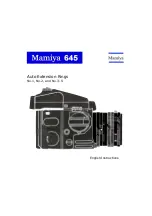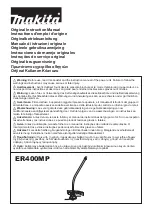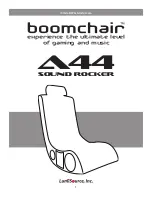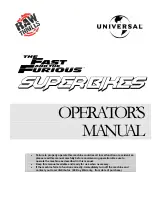
4.1.
breaking chain (pressing out link pin).
note:
this tool may be used for breaking all chain sizes from number 35 to 630.
if working on cam chain be sure and cover chain tunnel with rag to prevent parts dropping down.
4.1.1.
the rivet head must be ground off first.
4.1.2.
select correct size breaking tip (fig.2.3) for the chain to be worked on, position spring as shown fig.2 and insert into alignment bolt
(fig.2.1). Assemble tool as shown in fig.2 (Anvil not used).
4.1.3.
If small 2.2 mm tip is used you must also use the upper and lower guides (see fig.3) to prevent breaking the tip. The upper guide
threads onto the alignment bolt, the lower guide drops in place in bottom of tool body.
note:
smallest pin (2.2 mm) should be used on most cam chain. 2.9mm pin used on #25 or #35 chain 3.8 mm pin for most motorcycle
drive chain (428 to 530).
4.1.4.
Put tool over chain, breaker pin tip must be withdrawn at least 2 mm into alignment bolt. the end of the chain rivet should be held in
position by the tool alignment bolt, and the tool body. tighten the alignment bolt securely against chain to hold chain in place.
4.1.5.
tighten push (extractor) bolt with wrench or lever bar until the chain pin is pushed out completely the chain pin will drop out of
the hole in the bottom of the tool. (if you don’t feel the tip pushing down smoothly, check that the tip is correctly lined up against the
link pin. if not realign or you may break the breaker pin.) Withdraw push bolt and breaker pin, loosen alignment bolt and remove.
4.2.
installing chain link pin (riveting)
4.2.1.
the rivet tip and anvil must be in place in tool.
4.2.2.
Assemble the chain with the link to be riveted. new special rivet link pins must be used, the original pin must not be used
Do not
use a split pin type connecting link. the pin must be pushed all the way through the chain link, if the pin is hard to insert
it can be pushed into place by placing chain into the tool with the rivet tip withdrawn 2mm into the alignment bolt and tightening
the alignment bolt until the pin has been pushed through the link,ensure that an equal length of pin shows on each side of the link
4.2.3.
Position the tool over the pin to be riveted, make sure rivet tip is withdrawn 2mm into the alignment bolt and tighten the alignment
bolt securely against chain. Tighten the push (extractor) bolt so that the rivet tip flares the chain pin. Both ends of the chain link pin
should be flared so the pin is securely held in place. Repeat procedure on other link pin.
4.2.4.
Withdraw the tool, from the chain; visually check that both chain link pins show the same flared ends and that the rivets on the side
plates are in alignment with side plates on either side.
note:
You may also use the press plates to flare the ends of pins as shown below (fig.4); use the press plate with the two holes
in the upper jaw and the grooved press plate in the lower jaw. You may also use a combination of the rivet pin and lower press plate
as fig.5.
NOTE:
It is our policy to continually improve products and as such we reserve the right to alter data, specifications and component parts without prior notice.
iMportant:
no liability is accepted for incorrect use of this product.
Warranty:
Guarantee is 12 months from purchase date, proof of which will be required for any claim.
sole uK distributor, sealey Group.
Kempson Way, suffolk Business Park,
Bury st. edmunds, suffolk.
iP32 7Ar
www.sealey.co.uk
01284 757500
01284 703534
Vs779.V3 | issue 1 02/02/17
Original Language Version
© Jack sealey limited
environmental protection
recycle unwanted materials instead of disposing of them as waste. All tools, accessories and packaging should be
sorted, taken to a recycling centre and disposed of in a manner which is compatible with the environment.
When the product becomes completely unserviceable and requires disposal, drain off any fluids (if applicable)
into approved containers and dispose of the product and the fluids according to local regulations.
parts support is available for this product. to obtain a parts listing and/or diagram,
please log on to www.sealey.co.uk, email [email protected] or telephone 01284 757500.
fig.2
fig.3
fig.4
fig.5




















